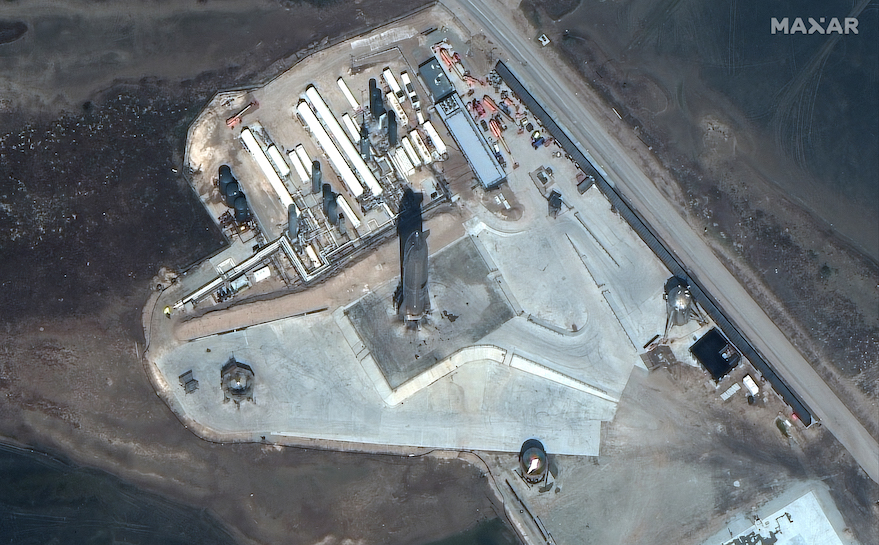Products You May Like
WASHINGTON — As SpaceX gears up for another test flight of a Starship prototype, the Federal Aviation Administration is facing new scrutiny from Congress for how it handled SpaceX’s violation of its launch license on an earlier test flight.
SpaceX had planned to launch its SN11 Starship vehicle March 29 from its Boca Chica, Texas, test site. That flight will be similar to those of previous Starship prototypes, going to an altitude of 10 kilometers before landing on a nearby pad.
However, SpaceX called off the March 29 launch attempt because an FAA inspector could not arrive to observe the flight during a five-hour window. “FAA inspector unable to reach Starbase in time for launch today,” tweeted Elon Musk, chief executive of SpaceX, using the proposed new name for the Boca Chica site. “Postponed to no earlier than tomorrow.”
The requirement for an FAA presence on site at the test site is new for the SN11 launch. The latest version of SpaceX’s FAA launch license for the Starship suborbital test flight program, issued March 12, allows those test flights to take place “only when an FAA Safety Inspector is present at SpaceX’s Boca Chica launch and landing site.”
The change stemmed from an investigation into SpaceX’s violation of that launch license during the SN8 test flight in December. SpaceX proceeded with the flight despite the FAA determining that the flight profile exceeded the maximum allowed risk to the uninvolved public for “far field blast overpressure” in the event of an explosion. While the SN8 vehicle exploded upon landing, there were no reports of damage outside of the SpaceX test site.
FAA directed SpaceX to investigate the incident, delaying the flight of the next Starship prototype, SN9. That investigation included “a comprehensive review of the company’s safety culture, operational decision-making and process discipline,” the FAA said in a Feb. 2 statement.
The FAA cleared SpaceX to proceed with launches, with SN9 and SN10 launching and landing — and both exploding upon or shortly after landing — on Feb. 2 and March 3, respectively. Neither caused any damage outside of the SpaceX test site.
The FAA’s response to SpaceX’s launch license violation, including the lack of any penalties beyond the investigation, prompted criticism from two key members of Congress. In a March 25 letter to FAA Administrator Steve Dickson, Reps. Peter DeFazio (D-Ore.) and Rick Larsen (D-Wash.) sought to “register our concerns” with the incident. DeFazio is chair of the House Transportation Committee and Larsen the chair of its aviation subcommittee.
“Given the high-risk nature of the industry, we are disappointed that the FAA declined to conduct an independent review of the event and, to the best of our knowledge, has not pursued any form of enforcement action,” they wrote after summarizing the incident and investigation.
In the letter, DeFazio and Larsen called on the FAA to “resist any potential undue influence on launch safety decision-making” by taking “all the time and actions necessary” to evaluate proposed launches. They also urged the FAA to implement “a strict policy to deal with violations of FAA launch and reentry licenses” that includes civil penalties, and to evaluate its current approach to safety oversight and enforcement for commercial space activities.
“While the commercial space transportation sector is crucial to our Nation’s future, at no point should a commercial space launch jeopardize public safety,” they wrote.
The FAA, asked March 29 about the letter, said only that the agency “is in receipt of the letter and will respond directly to the committee.”
While the House Transportation Committee’s oversight includes the FAA, traditionally that has excluded the FAA’s Office of Commercial Space Transportation, which is in the jurisdiction of the House Science Committee. The transportation committee, though, has shown a growing interest in commercial space transportation, including several hearings in recent years that have examined the industry, including how the growing number of launches and spaceports affects commercial aviation.
In a speech at the March 23 meeting of the FAA’s Commercial Space Transportation Advisory Committee (COMSTAC), Dickson indirectly referred to the SN8 incident. “We can’t take all the dangers out of commercial space transportation, but I also know that we have to make it as safe as humanly possible,” he said. “Sometimes, that means we have to set the parking brake and make sure that we’re all aligned.”
Dickson said there have been six commercial launch mishaps since the beginning of the 2021 fiscal year. That includes the three Starship test flights that ended in explosion upon or shortly after landing, as well as a failed Falcon 9 landing at sea during an otherwise successful launch Feb. 15. The other two are the launch of Astra’s Rocket 3.2 in December that just missed reaching orbit and an aborted test flight of Virgin Galactic’s SpaceShipTwo suborbital spaceplane, also in December.
“When mishaps do happen, which is not uncommon in a fast-moving new field, they should be successful failures, meaning that the failure was consistent with, in this case, the FAA’s analysis that showed that the public would be kept safe,” Dickson said.
“So far, there have been six mishaps this fiscal year, some that ended in spectacular fireballs and went viral on social media,” he said, “but all six of these were successful failures, because we were able to protect public safety.”
